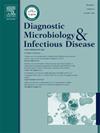Bacteraemia and proinflammatory response after non-surgical periodontal therapy and adjunctive antibiotics in patients with recent acute coronary syndrome
IF 2.1
4区 医学
Q3 INFECTIOUS DISEASES
Diagnostic microbiology and infectious disease
Pub Date : 2024-12-23
DOI:10.1016/j.diagmicrobio.2024.116662
引用次数: 0
Abstract
Introduction
This study compares the incidence of bacteraemia and proinflammatory cytokines in short and long periods after non-surgical periodontal therapy involving premedication with amoxicillin (AMX) followed by AMX and metronidazole (MTZ) in patients with Acute Coronary Syndrome (ACS).
Methods
This pilot study included twelve individuals with periodontitis and recent ACS. Six patients were treated with subgingival instrumentation (SI), and six with supragingival ultrasonic scaling (US). Amoxicillin 2 g was administered as premedication in the first visit, followed by AMX-MTZ for one week. The incidence of bacteraemia was evaluated using hemoculture, qPCR, and next-generation sequencing (NGS) before the treatment (t0) and 30 min later (t1) (quadrants 1 and 2), and after one-week, pre-post-treatment samples were taken from the re-maining quadrants (t3 and t4). Proinflammatory cytokines were evaluated in serum at baseline (t0), one week (t1), and six months (t5).
Results
Bacteraemia was low in 16.6 %, similar in both treatment groups. Porphyromonas gingivalis and Desulfobulbus oralis (16.6 %), Filifactor alocis, Eubacterium saphenum, Eubacterium brachy (8.3 %) were identified with qPCR. NGS was only detected in a single patient; at time t0, bacteria were more diverse than at t3 and were associated with the phyla Bacteroidetes and Proteobacteria. Interestingly, many clones observed in blood were non-oral. After treatment, all cytokines were reduced significantly in the SI group in the long term (p < 0.05).
Conclusions
Periodontal therapy reduced bacteremia: despite the antibiotic regimen, bacteria remained in peripheral blood, which could be associated with antimicrobial resistance. SI produced a more efficient reduction of proinflammatory cytokines after periodontal treatment in individuals with ACS.
求助全文
约1分钟内获得全文
求助全文
来源期刊
CiteScore
5.30
自引率
3.40%
发文量
149
审稿时长
56 days
期刊介绍:
Diagnostic Microbiology and Infectious Disease keeps you informed of the latest developments in clinical microbiology and the diagnosis and treatment of infectious diseases. Packed with rigorously peer-reviewed articles and studies in bacteriology, immunology, immunoserology, infectious diseases, mycology, parasitology, and virology, the journal examines new procedures, unusual cases, controversial issues, and important new literature. Diagnostic Microbiology and Infectious Disease distinguished independent editorial board, consisting of experts from many medical specialties, ensures you extensive and authoritative coverage.

 求助内容:
求助内容: 应助结果提醒方式:
应助结果提醒方式:


